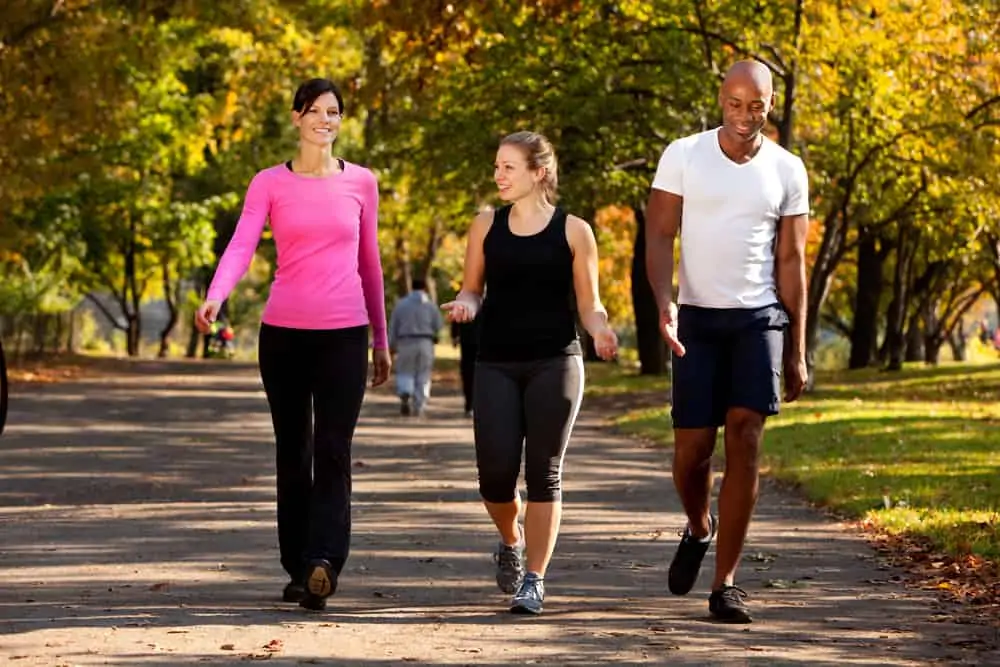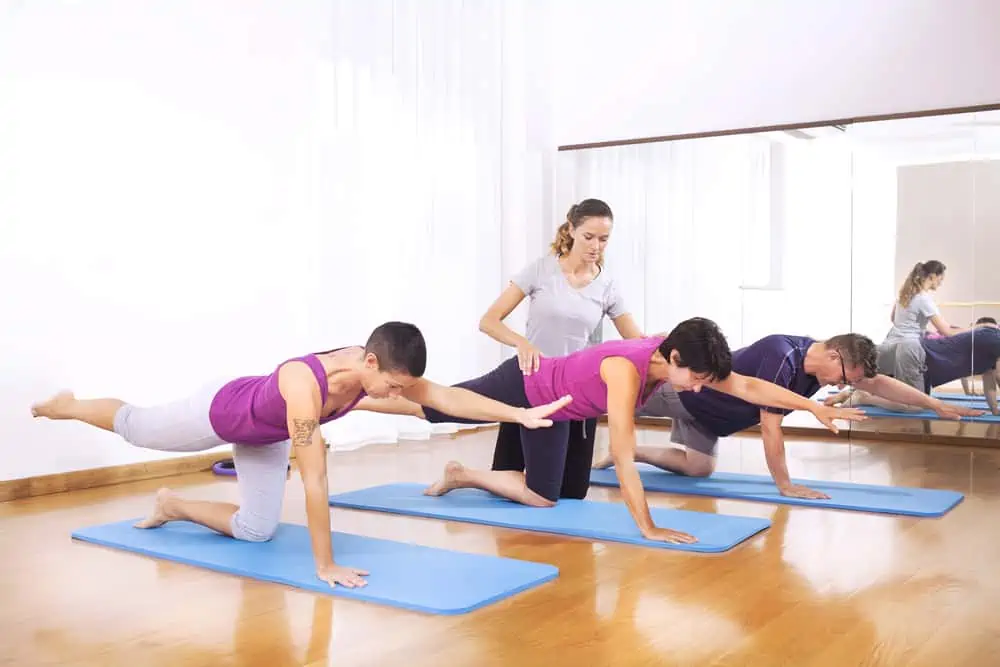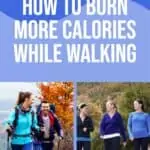This post may contain affiliate links. If you click through a link and make a purchase, I may receive a commission at no additional cost to you. As an Amazon Associate, I earn from qualifying purchases. Read the full disclosure here.
Walking is one of the most accessible, low-impact workout activities.
Whether you’re outside or on a treadmill, this low-impact aerobic exercise can help support a healthy fitness plan and meet daily physical activity goals.
10,000 daily steps is a popular goal (with questionable scientific roots) but when it comes to burning calories, quality matters more (especially when it comes to walking for weight loss).
If you’ve ever wondered how to burn more calories while walking, then this article has all the tips you need to get the most out of your walk.
Disclaimer: This content is for educational purposes and is not medical advice. Read the full disclaimer.
Actively engage your muscles
No casual strolling here, walk with a purpose.
To get the most out of your walking, be sure to actively engage your muscles.
This looks like standing up tall, pulling your shoulders back, having an awareness of your core, and making a conscious effort to engage your glutes with each step.
Try to keep up at least a moderate pace or a brisk walk to increase your heart rate and boost your aerobic activity.
Take bigger strides
By increasing your step length, you’ll naturally have to work harder.
The extra work that your muscles have to do to propel you forward by taking longer strides will help elevate your heart rate and grab some extra calories.
Pump your arms
Maybe you’ve rolled your eyes and serious power walkers passing by.
The reciprocal swing of your arms helps facilitate walking motion and encourage normal rotation of the body. And no, it doesn’t have to be that dramatic.
Getting your whole body involved not only increases your calorie burn but helps maintain a brisk pace.
If you’re walking on a treadmill, try not to hold on the entire time.
Not only does this decrease your heart rate, but it also sets you up for injury by blocking your natural reciprocal motion.
Wear the right shoes
Walking and running shoes have a construction that facilitates forward motion easier than training or casual shoes, plus, they have cushioning to absorb shock and keep your joints supported.
You also may be able to increase your walking speed with smoother form, and avoid blisters from shoes that weren’t meant for walking.
Casual “sneakers” I’m looking in your direction.
Slip-on style shoes or otherwise casual fashion sneakers do not have the right support to keep up with workouts, including walking.
This article explains what to look for when choosing shoes for any activity and this one outlines 11 signs you’re wearing the wrong shoes.
Follow an audio guided fitness walk
Do you get bored easily or quit early on a walk?
Whether you’re walking outside or on a treadmill, try following a guided workout on Aaptiv.
I use this app regularly on the treadmill or elliptical at the gym and it really helps pass the time.
Just zone out and follow the trainer’s cues and before you know it, you’re logging another workout done! The trainers also give plenty of the posture cues mentioned above so you can focus on your form.
Grab a free 30 day trial here or read my full review so you can see what everyone’s raving about.
Stop & add some strengthening
You don’t need any equipment to add some other exercises to your walk.
Adding a few bodyweight strength training exercises will increase your heart rate and provide additional strengthening for major muscle groups.
You can even use what’s around like a park bench for push-ups or dips and get your upper body involved.
Here are some ideas to include along your route:
- Squats
- Lunges
- Side lunges
- Push-ups
- Dips
Going up and down a few flights of stairs will also boost your workout intensity and help you burn more calories.
Add inclines or hills
Even small inclines can increase your heart rate and engage your posterior chain (a fancy phrase for the back of the body).
Plan your route around a few small hills or intermittent hit the incline button on the treadmill.
It doesn’t have to be a large incline. Small changes in elevation can have a big effect on your energy expenditure.
Try a weighted vest
Holding weights is a common addition to walking, but can lead to postural muscle imbalances causing neck, shoulder, or tennis elbow pain.
Instead of holding weights in your hands, try a weighted vest.
This study measured a 12% increase in calories burned when participants wore a weighted vest equal to 15% of their body weight.
The extra weight will cause you to expend more energy to keep up the same pace without the wear and tear on tendons and tissues.
This weighted vest on Amazon is an adjustable range with removable weights so you can gradually progress.
Try Nordic walking
Nordic walking is walking with the use of hand-held poles.
One study comparing Nordic walking with regular walking noted an average heart rate increase of 8.4% (with the highest being a 33 bpm increase) when walking at normal speeds.
Calorie burn was measured up to 45% higher with the use of walking poles.
Walking poles can also be useful for additional balance on uneven terrain.
Pump up your playlist
Music is a huge motivator for fitness. Songs with a catchy beat can help you increase your speed and get in the groove.
Check out what Amazon music is up to and remix your playlist full of motivating beats.
Wear your fitness watch
It’s fun to validate your hard work and see your heart rate and calories in real-time.
You can set a goal for time, distance, calories, or heart rate zones to hold you accountable during your walk.
Plus, you’ll know if you burned more calories using some of these suggestions.
Not sure if a fitness tracker is worth it? Read this article.
Use the RPE scale
If you don’t have a fitness watch and find it difficult to measure your heart rate, the RPE scale is an easy and valuable tool to measure workout intensity.
RPE stands for rate of perceived exertion and is a scale you can use to measure how hard you feel that you’re working.
The modern version of the RPE scale is based from 0 (no effort) to 10 (maximal effort).
You may also see an original scale that ranges from 6-20. The original theory was that where you fell on this scale roughly correlated with a heart rate.
For example, if your effort was a 13, then that may correlate with a heart rate of 130 bpm.
6-20 is pretty weird and people like easy round numbers, which is likely why there’s not a modified version from 0-10.
RPE scales are useful to any fitness level because it’s a personal perception of how you’re feeling in the moment.
Everyone is different. My version of moderate might be different than yours, but as long as we both feel we’re exerting “moderate” effort, that’s all that matters.
Add some interval training
Interval training involves increasing your intensity for short periods of time throughout a workout.
Although interval training has been popularized by HIIT and Tabata workouts, intervals don’t have to mean high intensity.
You don’t have to run. Sure you could, but you could also jog, use an incline, or just push your walking pace slightly faster.
These short bursts of intensity can help get your heart rate up.
Grab a gentle stretch after you walk
After your walk, the party doesn’t have to be over.
Tack on a little extra by taking some time to stretch after your walk. Here’s a post-workout gentle stretch from my YouTube channel.
Wrapping up
Walking is an accessible cardiovascular exercise and doesn’t have to be boring.
Use these tips to increase your energy expenditure and burn more calories on your next walk.
References
Takeshima N, Islam MM, Rogers ME, et al. Effects of nordic walking compared to conventional walking and band-based resistance exercise on fitness in older adults. J Sports Sci Med. 2013;12(3):422-430. Published 2013 Sep 1.







